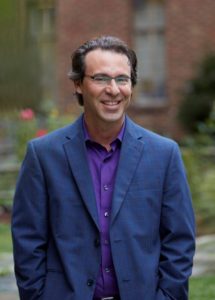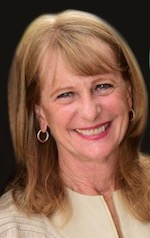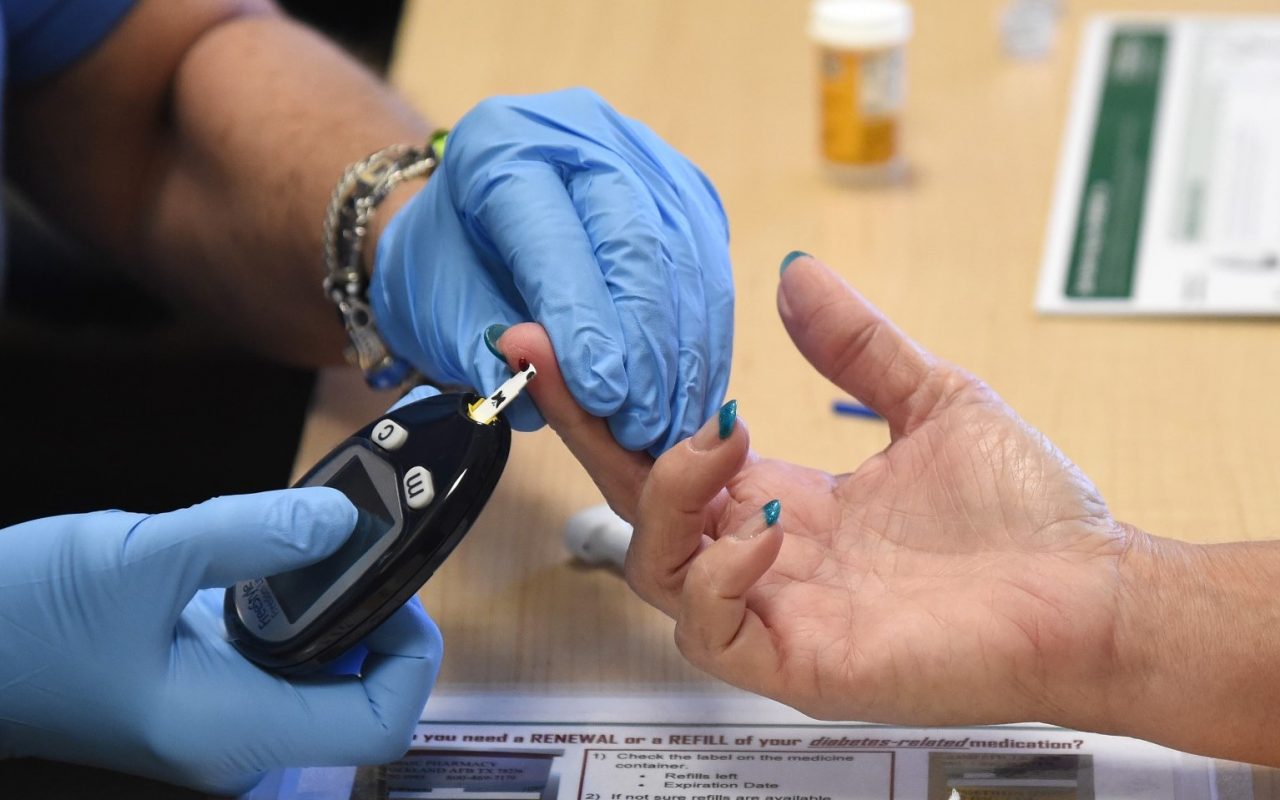Daily Business Report-Nov. 28, 2017
Diabetes test: Prevention programs can slow the disease and save money, experts say. (Image by Staff Sgt. Chelsea Browning/U.S. Air Force)
Diabetes hits hard in California,
which spends billions on treatment,
little on prevention
By Elizabeth Aguilera | CALmatters
A teenage girl walks the hardscrabble streets of Richmond, a Bay Area city, rapping about the challenges of drugs, violence — and diabetes. Here, she says, big dreams are “coated in sugar,” and innocence is “corrupted with Coke bottles and Ho Ho cupcakes.”
She’s performing in a video by a local youth group that counts diabetes, a national epidemic that has hit California hard, as one of the killers in her neighborhood. The disease, which is spreading and driving up health costs, now afflicts more than half the state’s adults, especially people of color and the poor. Experts say it doesn’t have to be that way, that prevention programs can slow the march of the illness and save money at the same time.
But efforts to legislate prevention — for example, by taxing the sugary drinks whose consumption contributes to diabetes — have stalled in the face of heavy opposition by the well-funded beverage lobby.
The state will soon begin funding a program for anti-diabetes education, counseling and lifestyle coaching, but it’s a modest investment regarded only as a start.
“Investing more now in diabetes prevention and education will save our state billions of dollars down the road,” said state Sen. Bill Monning, a Democrat from Carmel who has proposed soda taxes in the past and tried unsuccessfully this year to require warning labels on sweetened drinks.
A University of California, Los Angeles study last year found that 9 percent of adults in California have been diagnosed with diabetes, a chronic condition in which the body does not process sugar well and which can lead to blindness, heart disease, stroke and infections resulting in amputations. Forty-six percent — including about a third of those under 40 — are pre-diabetic, with elevated sugar levels that will likely develop into diabetes. That’s 55 percent of the state’s adult population swept up by the disease.
Treating diabetes costs government, private insurers and patients about $27.6 billion a year in California for such expenses as doctor visits, testing, medication, surgery and hospital costs, according to the American Diabetes Association. The state and federal governments shoulder most of that expense through Medi-Cal, which is California’s health program for those living in poverty, and the national Medicare system that covers seniors.
A state audit of the California Department of Public Health diabetes prevention efforts released two years ago said that California lagged in such spending. The state spent about $1 million from the federal Centers for Disease Control and Prevention, a sum that has since grown to $1.4 million, but did not devote state money to such programs. New York, the audit points out, was spending $7.2 million, although some of that money went to anti-obesity programs.
Beginning in July, with the next budget, $5 million in state funds will go toward a nutrition and exercise program for pre-diabetic enrollees in Medi-Cal. That project, based on a CDC model called the Diabetes Prevention Program, can cut the risk of developing diabetes in half, according to the CDC. In addition, it is expected to save about $45 million in treatment expenses over the next five years, said Assemblyman Joaquin Arambula, a Kingsburg Democrat and physician who co-chairs a health subcommittee.
Flojaune Cofer, an epidemiologist and director of state policy and research for the nonprofit Public Health Advocates, said that about 25,000 people will be able to participate each year. “We can’t just wait until people get sick because it’s not a viable system,” Cofer said.
The largest state pension fund, CalPERs, began offering the CDC program through its insurance plans this year and Medicare will offer it nationally next year. It is also offered by some private insurers.
But adult diabetes, or Type 2, doesn’t get the same attention as some other deadly diseases, such as cancer. Nor is it considered as blameless as Type 1 diabetes, a childhood disease diagnosed when the body produces little or no insulin.
Type 2 is considered mostly preventable by changes in diet and physical activity. But its spread has increased 32 percent in California in the past decade, according to state statistics.
The disproportionate impact on low-income communities and people of color may partly explain why it gets short shrift, experts say.

“There’s a general belief that it’s slothful, lazy people making bad choices,” said Dean Schillinger, professor of medicine at the University of California, San Francisco, a leading expert on diabetes and prevention and chief of the state’s diabetes control program from 2008 through 2013. “But if you have to choose between buying a fast-food meal for your family of five for $15 or going to Whole Foods and spending $80 on health food, it’s very rational what people are doing.”
Add to those economics the marketing of beverages and snack foods to children, especially through targeted advertising in low-income communities, and you have a natural intersection for the disease, he said. A federally funded study released this year found that diabetes grew at a rate of 4.8 percent among children each year between 2002 and 2012. “It’s an unacceptable state of affairs,” Schillinger said. “We can and must do something to prevent young people from having an amputation or being blind by the age of 30.”
Diabetes is also increasing among white people, Schillinger noted, just not as quickly. Sedentary lifestyles, fat-rich diets and time spent in front ofs creens large and small cut across all communities. Another contributor is a health care industry that has been primarily focused on treatment instead of prevention, said Monning: “Prevention, including diabetes prevention, is not profit-generating.”
He and a handful of other state legislators have been trying to pass measures to blunt the growth of diabetes for years, focusing on the role of sugar-sweetened beverages because they are the leading cause of increased calories in children. The lawmakers’ targets include not just sodas but also other sugary drinks camouflaged as more healthful: sports drinks, juices and enriched waters.
Monning tried this year to require labels on certain drinks to state that “drinking beverages with added sugar contributes to obesity, diabetes and tooth decay.” Other efforts have involved a statewide tax on such drinks, but that requires a two-thirds vote of the Legislature and has been a hard sell. The beverage industry argues that the causes of diabetes are complex, involving much more than soda, and that the best way to build strong, healthy communities is to work together to “help people balance their calories and improve their diets,” said Lauren Kane, a spokeswoman for the American Beverage Association. The group says taxes don’t work and labels are misleading.
“America’s beverage companies are already helping people cut their sugar intake from beverages through our collective efforts to reduce portion sizes and introduce smaller, more convenient packages with less sugar,” Kane said. But Monning blames the industry for pushing hard enough — and spreading enough money around Sacramento — to scare off the “yes” votes needed to pass preventive measures. The beverage group has spent $282,000 on lobbying in California so far this year, according to its required reports to the state. The two largest soda makers, PepsiCoand Coca-Cola, have spent about $248,000. And in the last five years PepsiCo and Coca-Cola have contributed nearly $783,000 to state candidate campaigns, while the American Beverage Association gave $135,000, the filings show. There has been a slight decline nationally in the consumption of soda, studies show, although the void may be at least partly filled with other sweet drinks. Experts credit local measures to tax sweetened beverages and require warning labels on billboards that advertise them, among other moves. Such taxes have been imposed in Berkeley, San Francisco and Oakland. Others, including Richmond, have tried and failed to pass them. San Francisco approved a requirement two years ago that certain beverage ads be labeled, but the beverage industry sued to block the measure in a case that is ongoing.
More local taxes and labeling requirements could prompt state lawmakers into action eventually, as plastic-bag bans throughout the state did, said Monning. Once a tipping-point number of cities outlawed the bags, it became easier for the Legislature to adopt a statewide policy.Schillinger said he has seen first-hand that prevention efforts can stem, or even reverse, an epidemic tide. When he started his medical career, at the height of the AIDS epidemic, half his patients were dying from HIV infection, he recalls. Within 15 years that epidemic was pushed back by a combination of grassroots activity, well-funded public health work and scientific research, he said.
“At that time, one out of 15 to 20 of my patients had diabetes,” he said. “Flash forward and I have no patients with AIDS who are dying. Our AIDS ward is empty. But instead we have the diabetes epidemic,” and half his patients have the disease.
Schillinger lauds community awareness efforts, like the videos posted by Youth Speaks as part of its diabetes-prevention program. Even armed with statistics and an M.D. degree, Schillinger said, he has participated in too many disappointing policy discussions with lawmakers about diabetes.
“There has to be a different way to talk about this,” he said, “and it has to come from different people.”
CALmatters.org is a nonprofit, nonpartisan media venture explaining California policies and politics.
____________________

UC San Diego to Join NCAA
Division 1 Big West Conference
UC San Diego has accepted an invitation to join the Big West Conference, paving the way for National Collegiate Athletic Association (NCAA) Division I reclassification. The move fulfills the wishes of the student body, which voted overwhelmingly last year to move UC San Diego Athletics to Division I.
“Elevation to NCAA Division I athletics is a reflection of UC San Diego’s culture of risk-taking, collaboration and innovation,” said Director of Athletics Earl W. Edwards. “Aligning with peer institutions and competing at the highest levels in all endeavors is one of the reasons for the transition to Division I. We are extremely excited to be joining the Big West Conference with their strong history of success in a broad base of sports.”

The Big West Conference, in its 49th year of operation, is comprised of nine institutions, including four other University of California campuses, and sponsors 18 sports. With 17 national team titles, Big West student-athletes have also succeeded on a worldwide stage in the Olympics, Pan-American Games and the World Cup.
The Tritons will begin a full Big West competitive slate in the 2020-21 academic year. Two sports will join the Conference early, beginning with Men’s Volleyball starting its first full season of Big West participation this year (2017-18). Women’s Water Polo will commence Conference play in 2019-20.
Following an NCAA-mandated four-year reclassification period, UC San Diego will be a full member of the Big West Conference and eligible for all Big West Championships in NCAA Division I sports in Fall 2024. National Collegiate Sports (NCAA sports with only one combined division) remain eligible for Big West and NCAA Championships during the four-year reclassification process. Triton National Collegiate Sports include men’s volleyball, men’s and women’s water polo, and fencing.
____________________
San Diego County Slow
to Implement Granny Flat Law
By Sara Libby | Voice of San Diego
Granny flats — small housing units that often exist in the form of converted garages or freestanding structures in homeowners’ backyards — were a fixture throughout San Diego County even before Gov. Jerry Brown signed a bill last year that made them easier to build.
The law, written by Sen. Bob Wieckowski, essentially reduces the authority of local governments over the granny flat building process.
But so far only seven of the 19 jurisdictions in San Diego County have updated their granny flat ordinances, and there is still confusion about what the law means for cities, architects and homeowners.
Wieckowski and Greg Nickless of the state’s housing and community development department tried to address some of those concerns at a recent conference in San Diego.
One area of pushback has been parking requirements, Nickless said. For instance, some cities still want to require homeowners who convert a garage into a granny flat to construct a new parking garage as a replacement. The law tossed out such requirements.
“It has been 30 years where we deal with local jurisdictions that say, ‘You don’t understand, but we’ve got a parking problem.’ I understand. I know you have a parking problem, but we have a housing problem,” Wieckowski said.
California ranks next to last in the country in housing units per capita, according to stats provided by Wieckowski’s office. State lawmakers are treating the construction of granny flats – and lowering other local barriers to construction – as remedies to the housing crisis.
“We’ve heard time and time again that we need to decrease the cost of new housing production, and we need to create more naturally affordable homes for California — [granny flats] check both of those boxes at the same time,” said Sen. Toni Atkins, who co-wrote the granny flat bill.
While the law simplified the process of building a granny flat, onerous fees may be keeping many homeowners from actually building them.
The fees for building a granny flat in San Diego are comparable to fees required for building a 20,000 square-foot home, said Sarah Jarman, a consultant for the San Diego City Council’s Smart Growth and Land Use Committee.
On Nov. 8, the committee will vote on whether to waive some granny flat fees, which would reduce the total from more than $15,000 to about $2,000. That does not include other fees the city has no control over, such as fees from private water companies.
Though applications for granny flat permits have increased in San Diego from 12 applications in 2016 to 48 this year, the city is far from its goal of 6,000 new granny flats in the next decade.
____________________
Researchers for Head and Neck Cancers
Get Boost from V Foundation Grant
A team of University of California San Diego School of Medicine and Moores Cancer Center researchers studying new drugs designed to break resistance to cancer immunotherapy has been awarded a V Foundation for Cancer Research translational grant of $600,000 over three years.
Led by Judith A. Varner, PhD, professor in the departments of Pathology and Medicine at UC San Diego School of Medicine, the team will build upon research recently published in the journal Nature in which they identified the enzyme PI-3 kinase gamma (PI3Ky) as a molecular switch controlling immune suppression. The researchers will conduct clinical trials to test a PI3Ky inhibitor, called IPI-549, alone and in combination with other drugs in head and neck cancers to boost the effectiveness of immunotherapy.
____________________
Executive Search Firm CEO Sue Major Elected
to National board of Girl Scouts of the USA

Sue Major, CEO of San Diego-based Major Executive Search, has been elected to the national board of Girl Scouts of the USA. The Rancho Santa Fe resident will serve a three-year term as a member-at-large and participate on the Board Development Committee.
The board is responsible for the governance and fiduciary administration of Girl Scouts of the USA, a 105-year-old nonprofit organization with 2.6 million members. Major was elected during GSUSA’s recent convention in Columbus, Ohio.
“The GSUSA board maintains the legacy of Girl Scout founder Juliette Gordon Low, helping girls develop the courage, confidence and character they need to make the world a better place,” Major said. “This is an exciting opportunity to give back to an organization that did so much for me.”
Major is a member of a three-generation Girl Scout family that includes her mother, sisters, daughter and nieces. She has a passion for encouraging girls to use Girl Scouts’ STEM (science, technology, engineering and math) programs to explore nontraditional careers.
Major has held several volunteer leadership positions with Girl Scouts San Diego. She completed two terms as a board director, chaired the Fund Development Committee, and served on the Board Development Committee.
She and her husband, John Major, co-chaired Girl Scouts San Diego’s Urban Campout fundraiser in 2016 and have provided significant support for the organization’s capital campaigns.
Major Executive Search is a global, retained executive search firm that helps technology companies strengthen and grow their executive teams and boards of directors. In addition to working for 17 years in the executive search field, Major has 15 years of experience in technology development at international companies. She holds two patents for wireless messaging inventions.
____________________
Halo Business Intelligence
Acquired by Logility Inc.
Atlanta-based Logility Inc. has acquired privately-held Halo Business Intelligence, a San Diego-based supplier of advanced analytics and business intelligence solutions for the supply chain market.
Halo, a leader in data visualization and advanced analytics for more than a decade, has developed innovative supply chain analytics that transform data from disparate enterprise systems into intelligent and actionable business information.
Halo’s advanced analytics will be embedded into the Logility Voyager Solutions advanced analytics platform.
____________________
El Cajon Senior Community Announces
New Name, New Management
Local senior living community The Springs of El Cajon is under new management, and has a new name: Solstice Senior Living at El Cajon. The announcement results from a recently launched, national joint venture, Solstice Senior Living, between the property’s ownership group, NorthStar Healthcare Income, Inc., (NHI) and Integral Senior Living, a premier provider of senior living management services nationally.
Solstice Senior Living has assumed management of 32 NHI-owned independent living communities nationally.
Gerald “Gerry” Jackson has been named Solstice’s senior vice president. Jackson has more than 30 years of experience in senior living, assisted living and behavioral health, including leadership roles in training, operations, and program and staff development.
____________________
San Diego Home Prices Continue to Spike,
With 8.2 Percent Rise Over Past Year
San Diego home prices continued their last-summer spike in September, and are up 8.2 percent over the past year, according to the authoritative Case-Shiller Index. The report released Tuesday morning ranked Seattle, Las Vegas and San Diego as the three metropolitan areas with the fastest growing home prices. San Diego prices rose 0.5 percent in September
____________________
Personnel Announcements
Cubic Names Kirsten Nielsen VP of Investor Relations

Cubic Corporation announced the appointment of Kirsten Nielsen as vice president of investor relations. Nielsen, an experienced finance executive with a strong investor relations and investment banking background, will be responsible for the development and execution of Cubic’s investor relations strategy to include strategic positioning, messaging and communications to the financial and investor community.
Prior to joining Cubic, Nielsen served as director, investor relations at Arconic (formerly Alcoa), a global engineering and manufacturing firm. Prior to that, Nielsen held financial roles in the areas of investor relations and corporate development at Arconic and mergers and acquisitions at SunTrust Robinson Humphrey. Nielsen holds an MBA from the Darden School of Business at the University of Virginia and a B.S. from the University of Florida.
“(Nielsen’s) knowledge and experience brings a unique perspective to our business at an exciting time for our company,” said Anshooman Aga, executive vice president and chief financial officer.




